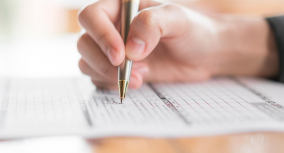IELTS stands for InternationalEnglish Language Testing System.Simply put, it’s an exam that measures your English language proficiency. You’ll need it if you want to move to an Anglophone country. The exam is owned by the British Council, IDP Australia, and the University of Cambridge.
You may think it’s too difficult to get ready for the test by yourself. We’ve got good news for you! Ourcustom writingteam has compiled a comprehensive guide that will help you prepare at home, for free and without coaching. From it, you will learn:
-
Whattaking IELTSis like;
-
How toapproach preparation;
-
Ways oftraining your language skills
What Taking IELTS Is Like
So, you’ve decided to take the IELTS. First off, it’s crucial to know what you’re up against. There are two versions of the test:
-
IELTS Academicassesses whether your language level is suitable for studying in an academic environment.
-
IELTS General Trainingfocuses on your everyday English. It analyzes your fluency in social and work situations.
While the Listening and Speaking parts are similar in both types, Writing and Reading differ slightly. These differences are described below.
The exam lasts 2 hours and 45 minutes in total. It’s divided into four parts:
-
Reading tasks include multiple-choice questions or matching and completion exercises. The difference between General Training and Academic Reading is in the texts’ difficulty. The texts are taken from everyday life for the former, and they’re chosen from academic documents for the latter.
-
Writingconsists of two tasks. The first task in General Training is creating a letter. In IELTS Academic, it’s analyzing a graph. The second task in both types is composing an essay.
-
Listening requires you to solve tasks regarding the contents of four audio recordings. They’re read by native English speakers with various accents.
-
In the s peaking part, you’ll answer basic questions about yourself. Then, you’ll need to talk about a random topic. You’ll have a few minutes for preparation.
Keep in mind that it’s possible to do the speaking exercise separate from the rest. However, you’ll have to complete all the other parts without a break.
Now, you probably want to know the best preparation tips. Keep reading and find out!
✅ How to Prepare for IELTS at Home: Step-By-Step
Taking an important exam such as IELTS takes many hours of preparation. Let’s break the process down for a better overview:
In the end, studying by yourself requires a lot of dedication. But if you stay on track, your hard work will eventually pay off.
Working on Your IELTS Skills
IELTS evaluates all aspects of language proficiency. It means you need to train four essential skills:speaking,listening,writing, andreading.

How to Prepare for IELTS Listening
This part’s primary goal is to assess your listening comprehension. An additional challenge is that you will hear a variety of accents. It may be hard if you haven’t heard them before. Besides, the speed of speech may vary.
所有这些意味着要听native English speakers from different regions with varying speech tempos. To practice your comprehension, you can listen to:
-
Podcasts. Chances are, you already have an app for this. You can listen to podcasts at all times: on the go and while cooking or cleaning. Choose a subject you particularly enjoy and have fun while learning. There are also programs designed specifically for language learners.
-
TED Talks.TED Talkspresent interesting ideas on a variety of topics. There you can easily find speakers from different English-speaking countries. It’s perfect for practicing all kinds of accents.
-
The news. It’s always good to stay informed! Listening to the news is a fantastic method to improve your skills with real-life topics. Besides, you can jot down vocabulary that might be handy in the Speaking part.
-
TV shows/movies. This is the best way to combine learning and fun. The choice of films in English is endless. Whatever your taste, you’ll always find something to watch. Moreover, TV is great for broadening your understanding of colloquialisms and pop culture.
Best Way to Prepare for IELTS Reading
Many test-takers consider reading the easiest part of the IELTS. They assume not much time is required to prepare for it. That’s not entirely true: there are still plenty of skills you can learn to make your reading more effective.
First off, reading is about technique. It means that there are different approaches for various kinds of texts. The four main methods arescanning,skimming,intensive, andextensive reading. The first two are for basic comprehension of texts, while the other two are for deeper understanding.
If you know how to use these techniques efficiently, you’ll save yourself time and effort. Here are some methods you can use:
-
Learn how to skim and scan. When you first see the text, you’ll want to understand its content quickly. The techniques associated with it are skimming and scanning. The latter involves looking for information without regarding the broader context.
-
Watch out for keywords. Every question has words in it that show you what to search for. Learn how to spot them and scan the texts looking specifically for these words of synonyms.
-
Don’t try to understand every word. For most questions, you don’t even need to comprehend the entire context. It’s good if you get the gist. Still, quick and effective locating of answers depends on your reading skills. Practice with various types of texts, expand your vocabulary, and you’ll ace this part.
️ How to Prepare for IELTS Speaking
现在,你可能会认为你只能练习speaking with a partner. It indeed makes training easier. And if you have the time and money, it’s sensible to invest in a professional IELTS tutor. But that doesn’t mean it’s impossible to do alone. Here’s what you can do:
-
Familiarize yourself with common topics.These include travel, technology, hobbies, media, and the environment. Then, read model answers or even essays on these topics. There’s no need to memorize them. Just collect ideas, viewpoints, and words associated with them.
-
Practice making speeches spontaneously.For this, you can choose topics at random. Simply say whatever comes into your mind. The point is to develop fluency: try to be as spontaneous as possible.
-
Record yourself when practicing at home. There are many IELTS tutorial videos on the internet. You can use them to rehearse answering the instructor’s questions by yourself. When you do this, set a timer and record yourself with a dictaphone. This way, you can listen to your mistakes and correct yourself on playback.
✍️ How to Prepare for IELTS Writing
The IELTS writing task comes in two types. They, in turn, each have two parts. In Academic test, the first one will require you toanalyze a chart or diagram. In General Training, it’swriting a letter. The second task in both types is an essay
In IELTS Writing task 2, you can encounter one of the following essay types:
-
Opinion, where you explain why you agree or disagree with a given statement.
-
Advantages and disadvantages, where you discuss the pros and cons of something.
-
Discussion, where you look at both points of view and give your opinion.
-
Problem and solution, where you pinpoint issues associated with something. Then, you suggest how to solve them.
-
Two-part questions, where you answer two questions following a statement.
Practice writing these types of essays with and without a timer. With enough exercise, you’ll succeed with this task easily.
While practicing essays is something you can do right away, the other two tasks are more specific. Let’s have a look at the skills you’ll need to sharpen if you want to ace them.
How to Prepare for IELTS Writing: Academic
When it comes to Academic Writing, the main types of images in task 1 are:
-
Line graphsshow how change occurred over time in one or several objects.
-
Bar chartscompare two different objects over time.
-
Pie chartsconvey percentages. In this type of task, you usually determine the most important among several factors.
-
Tablescontain numerical data about objects. They usually show statistics.
-
Mapspresent one or two locations with their main features.
-
Processis an image that shows steps required for something to be made or occur.
All these types of illustrations require different approaches. That’s why it’s crucial to learn tointerpretcharts and diagrams. Here are some examples:
-
Inline charts, pay attention to the points at the beginning and the end.
-
In graphs that show改变over time, establish how the change occurred.
-
If a picturecomparestwo things, determine and describe their differences.
You can practice describing graphs in a structured way using mock tests. Try working with various types of illustrations. Here’s how to do it:
-
In an introduction,give background informationabout the graph. Say what exactly is presented on it.
-
Determine the primary trendand state it right away.
-
In the body paragraphs,describe this trend in detail. Don’t forget to use numerical data to illustrate your point.
-
Learnwords and combinationsthat will help you describe change over time:
How to Prepare for IELTS Writing: General Training
Are you preparing for the General Training test? In this case, consider learning to writedifferent types of letters. Here’s what you’re likely to encounter in Writing task 1:
-
Personal letter.It’s usuallyaddressed to a friend or a family member. In it, you discuss situationsrelated to personal life. You can write it in neutral or informal language using contractions (I’m, it’s, etc.) Invitations, apologies, requests, and informative letters are usually personal.
-
Formal letter .This type of letter usually hasofficial purposes. It discussesprofessional or formal situations. You should write it in a formal style with no contractions (I am, it is, etc.) Application letters, complaints, and arrangements are usually formal.
-
Semi-formal letter.Like with personal letters, this type isaddressed to a friend or a family member. However, instead of personal matters, it discusses一个正式的场合. For example, it can be about work. Depending on the situation, invitations, requests, explanations, and informative letters can be semi-formal.
Another thing to consider when writing a letter is how you start and end it. Naturally, you start with a greeting and finish with signing off. However, the phrasing differs depending on the letter’s style. Study theseopening and closing phraseswhile practicing your letter writing.
Thank you for reading through our article. Now you’re ready to start training for the IELTS. We wish you the best of luck!
Preparing for the IELTS is hard work. But if you start soon enough, you’ll be able to get a satisfying band score. Be sure to practice all four IELTS skills. And don’t forget to have fun!
Frequently Asked Questions
For Canada express entry, you’ll need at least a 6.0. For US universities, the minimum is 6.5, as is the case for Germany. A 7.0 IELTS score is required for the UK’s top universities. Australia applies the same standard. Scores for immigration might be a bit higher.
In general, the certificate stays valid for two years after you get the result. This is true for Canadian and Australian immigration and other countries for immigrants and students alike.
Some are ready in one month; some manage to do it in two months. Others can cram enough practice time into just 15 days. All in all, it depends on the individual.
It’s smart to make a self study plan. Here are the steps:
1. Familiarize yourself with the test’s questions.
2. Judge your skills accurately.
3. Practice your English skills.
4. Get feedback.
Further reading:






![Unexpected Career Tips from Celebrities [2023 Edition]](http://www.allgiftz.com/blog/wp-content/uploads/2021/01/Career-tips-title-1-284x153.jpg)